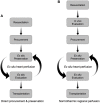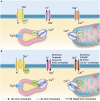Transplantation of Hearts Donated after Circulatory Death
- PMID: 29487855
- PMCID: PMC5816942
- DOI: 10.3389/fcvm.2018.00008
Transplantation of Hearts Donated after Circulatory Death
Abstract
Cardiac transplantation has become limited by a critical shortage of suitable organs from brain-dead donors. Reports describing the successful clinical transplantation of hearts donated after circulatory death (DCD) have recently emerged. Hearts from DCD donors suffer significant ischemic injury prior to organ procurement; therefore, the traditional approach to the transplantation of hearts from brain-dead donors is not applicable to the DCD context. Advances in our understanding of ischemic post-conditioning have facilitated the development of DCD heart resuscitation strategies that can be used to minimize ischemia-reperfusion injury at the time of organ procurement. The availability of a clinically approved ex situ heart perfusion device now allows DCD heart preservation in a normothermic beating state and minimizes exposure to incremental cold ischemia. This technology also facilitates assessments of organ viability to be undertaken prior to transplantation, thereby minimizing the risk of primary graft dysfunction. The application of a tailored approach to DCD heart transplantation that focuses on organ resuscitation at the time of procurement, ex situ preservation, and pre-transplant assessments of organ viability has facilitated the successful clinical application of DCD heart transplantation. The transplantation of hearts from DCD donors is now a clinical reality. Investigating ways to optimize the resuscitation, preservation, evaluation, and long-term outcomes is vital to ensure a broader application of DCD heart transplantation in the future.
Keywords: Ex vivo heart perfusion; donation after circulatory death cardiac graft; donation after circulatory death heart transplantation; ex situ heart perfusion; ischemic post-conditioning.
Figures





References
-
- Lund LH, Edwards LB, Kucheryavaya AY, Benden C, Dipchand AI, Goldfarb S, et al. The registry of the international society for heart and lung transplantation: thirty-second official adult heart transplantation report-2015; focus theme: early graft failure. J Heart Lung Transplant (2015) 34(10):1244–54.10.1016/j.healun.2015.08.003 - DOI - PubMed
-
- 2016 CORR Snapshot. Treatment of End-Stage Organ Failure in Canada, Canadian Organ Replacement Register, 2005 to 2014. Canadian Institute for Health Information; (2016).
-
- Canadian Institute for Health Information. Canadian Organ Replacement Register Annual Report: Treatment of End-Stage Organ Failure in Canada, 2004 to 2013. Ottawa, ON: Canadian Institute for Health Information; (2015).
-
- Ross H, Hendry P, Dipchand A, Giannetti N, Hirsch G, Isaac D, et al. 2001 Canadian cardiovascular society consensus conference on cardiac transplantation. Can J Cardiol (2003) 19(6):620–54. - PubMed
Publication types
LinkOut - more resources
Full Text Sources
Other Literature Sources

